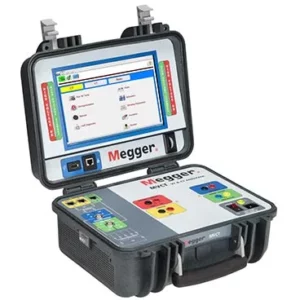
Megger MRCT
- Industry leading test duration using patented simultaneous multi-tap measurements reduces testing time by 20% on multi-tap CTs
- Accuracy to support testing of metering and protection class CT
- Integrated single phase relay test system
- Grouped testing: demagnetization, knee points, ratios, saturation curves, winding
- resistance insulation and more
- Measure all ratios and saturation curves on multi-tap CTs with one lead connection
- Optional DC excitation technique for testing CTs with kneepoints up to 30 kV
- Optional Integrated VT/CVT test system
The Megger MRCT is a light weight, robust, portable unit used to perform demagnetization, ratio, saturation, winding resistance, polarity, phase deviation, and insulation tests on current transformers. The MRCT automatically calculates ratio errors, saturation curves, and knee points. The MRCT provides a microprocessor-controlled variable voltage and current output and precision instrumentation for automatically testing single and multi ratio CTs, reducing testing time and increasing productivity. The MRCT will directly connect to multi ratio CT’s and perform all tests – saturation, ratio and polarity, winding resistance and insulation – on all taps with the push of a button and without changing leads.
The MRCT can be controlled via Megger’s Smart Touch View Interface (STVI) controller, a full color, high resolution, LCD touch screen which allows the user to perform manual and automatic testing quickly and easily using the manual test screen, as well as using pre-constructed test routines. The large display permits the user to easily read all pertinent data while the test is being performed and provides the ability to view the current transformer’s saturation curve. The unit can also be configured to come without a Megger STVI and can be controlled via a laptop with Megger’s PowerDB software.
Current transformers can be tested in their equipment configuration, such as being mounted in transformers, oil circuit breakers or switchgear. It is necessary for the equipment to be completely isolated from the electrical system prior to testing.






